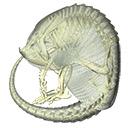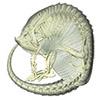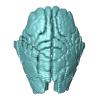3D models of early strepsirrhine primate teeth from North Africa
3D models of Pontognathus ignotus and Massetognathus pascuali
3D models of Protosilvestria sculpta and Coloboderes roqueprunetherion
3D GM dataset of bird skeletal variation
Skeletal embryonic development in the catshark
Bony connexions of the petrosal bone of extant hippos
bony labyrinth (11) , inner ear (10) , Eocene (8) , South America (8) , Paleobiogeography (7) , skull (7) , phylogeny (6)
Lionel Hautier (22) , Maëva Judith Orliac (21) , Laurent Marivaux (16) , Rodolphe Tabuce (14) , Bastien Mennecart (13) , Pierre-Olivier Antoine (12) , Renaud Lebrun (11)
MorphoMuseuM Volume 10, issue 02
<< prev. article next article >>

|
3D dataset3D models related to the publication: Exon capture museomics deciphers the nine-banded armadillo species complex and identifies a new species endemic to the Guiana Shield.Mathilde Barthe
Published online: 28/06/2024 |

|
M3#1200Skeleton and carapace Type: "3D_surfaces"doi: 10.18563/m3.sf.1200 state:published |
Download 3D surface file |

|
M3#1201Frontal sinuses Type: "3D_surfaces"doi: 10.18563/m3.sf.1201 state:published |
Download 3D surface file |
Arteaga, M. C., Gasca-Pineda, J., Bello-Bedoy, R., Eguiarte, L. E., & Medellin, R. A. (2020). Conservation genetics, demographic history, and climatic distribution of the nine-banded armadillo (Dasypus novemcinctus): an analysis of its mitochondrial lineages. Conservation genetics in mammals: integrative research using novel approaches, 141-163. https://doi.org/10.1007/978-3-030-33334-8_7
Billet, G., Hautier, L., De Thoisy, B., & Delsuc, F. (2017). The hidden anatomy of paranasal sinuses reveals biogeographically distinct morphotypes in the nine-banded armadillo (Dasypus novemcinctus). PeerJ, 5, e3593. https://doi.org/10.7717/peerj.3593
Barthe M., Rancilhac L., Arteaga M. C., Feijó A., Tilak M.-K., Justy F., Loughry W. J., McDonough C. M., de Thoisy B., Catzeflis F., Billet G., Hautier L., Nabholz B., and Delsuc F. (2024). Exon capture museomics deciphers the nine-banded armadillo species complex and identifies a new species endemic to the Guiana Shield. Systematic Biology, syae027. https://doi.org/10.1093/sysbio/syae027
Feijo, A., Patterson, B. D., & Cordeiro-Estrela, P. (2018). Taxonomic revision of the long-nosed armadillos, Genus Dasypus Linnaeus, 1758 (Mammalia, Cingulata). PloS one, 13(4), e0195084.
https://doi.org/10.1371/journal.pone.0195084
Feijó, A., Vilela, J. F., Cheng, J., Schetino, M. A. A., Coimbra, R. T., Bonvicino, C. R., ... & Cordeiro-Estrela, P. (2019). Phylogeny and molecular species delimitation of long-nosed armadillos (Dasypus: Cingulata) supports morphology-based taxonomy. Zoological Journal of the Linnean Society, 186(3), 813-825. https://doi.org/10.1093/zoolinnean/zly091
Hautier, L., Billet, G., De Thoisy, B., & Delsuc, F. (2017). Beyond the carapace: skull shape variation and morphological systematics of long-nosed armadillos (genus Dasypus). PeerJ, 5, e3650. https://doi.org/10.7717/peerj.3650